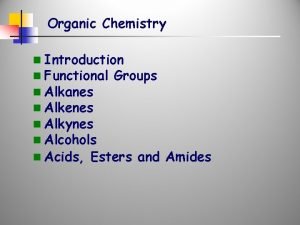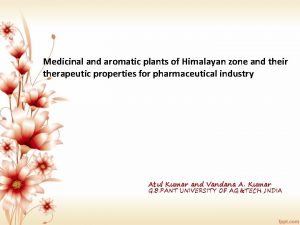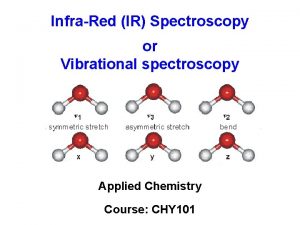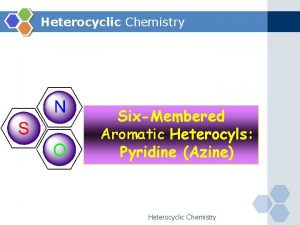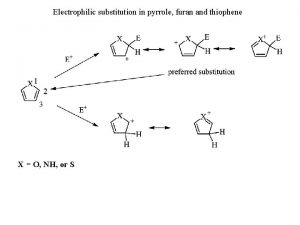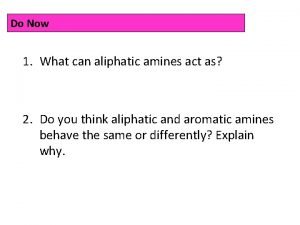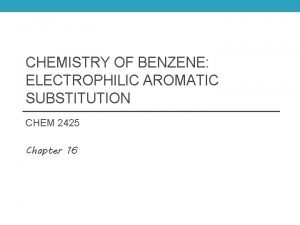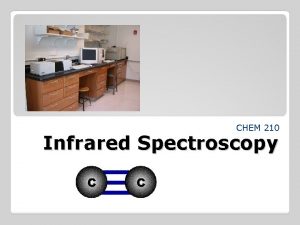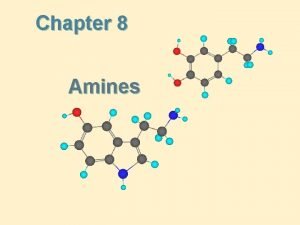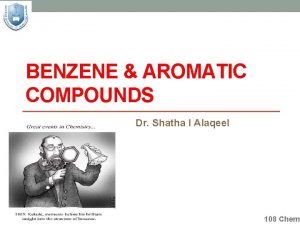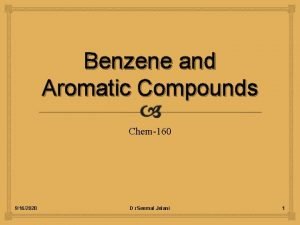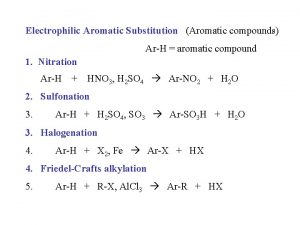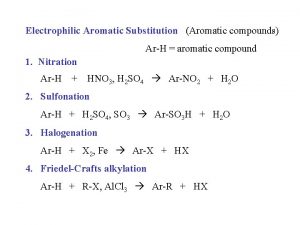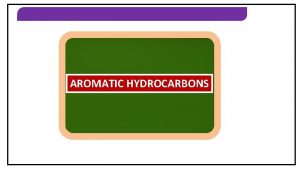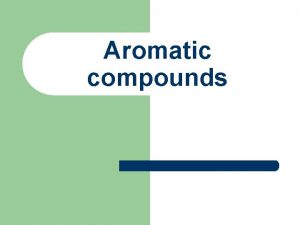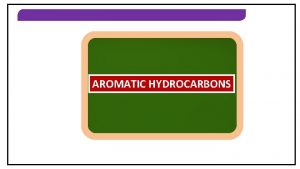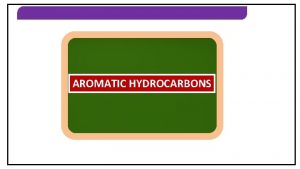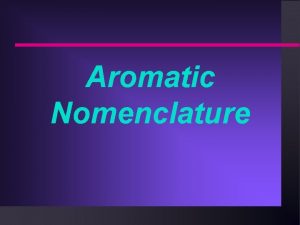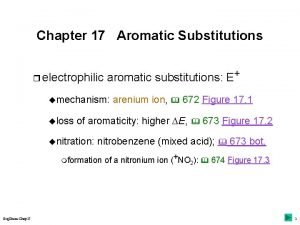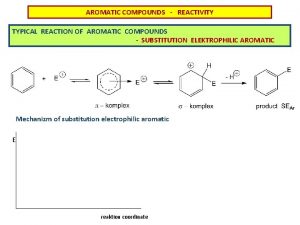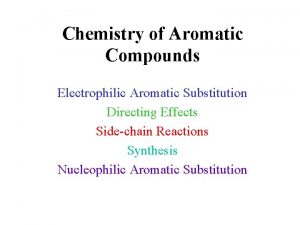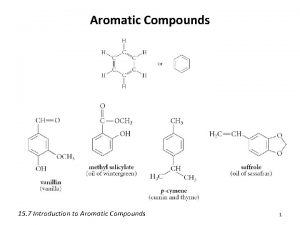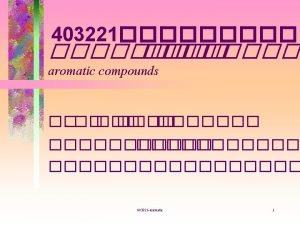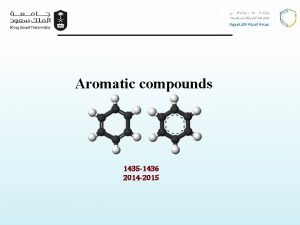Aromatic Reactions Most common reactions for aromatics involve

















- Slides: 17

Aromatic Reactions Most common reactions for aromatics involve replacement of ring hydrogens by other atoms or groups (substitution reactions)

Mechanism of Electrophilic Aromatic Substitution Reactions • Electrophile – a reagent with a strong demand for electrons • Carbocation – a positive charged carbon fragment • Nucleophile – a negative ion, or one with an unshared electron pair • The aromatic ring acts as a “supplier” of electrons to the electrophile (similar to how an electrophile attacks an alkene double bond)

• The major difference with aromatics is that the carbonium ion intermediate is resonance stabilized • Halogenation. . : Cl: + Fe. Cl 3. . . nucleophile : Cl+ + Fe. Cl 4. . electrophile – attacks a double bond • • • . . : Cl+

• the positive charge can be delocalized to the carbon atoms that are ortho & para to the position taken by the chlorine • delocalized – an electron can move through more than its two carbons – this type of molecule is more stable Carbocation intermediates Resonance forms of a benzonium ion (benzene ring with a positive charge)

1. Electrophilic Aromatic Substitution Reactions • a. Halogenation – requires the presence of an iron catalyst (Fe. Cl 3 or Fe. Br 3) to convert Cl 2 or Br 2 (weak electrophiles) to Cl+ or Br+ (strong electrophiles) • Ex. ; Chlorinate benzene

• b. Nitration - uses HNO 3 in the presence of H 2 SO 4 • Ex. ; Nitrate benzene.

• c. Alkylation (Friedel-Crafts Reaction) - Discovered by Frenchman Charles Friedel and American James Craft in 1877. - Any alkyl halide in the presence of an aluminum halide catalyst reacts with an aromatic - Ex. ; React benzene with chloromethane. - Ex. ; React benzene with ethylchloride

• d. Sulfonation - an aromatic reacting with H 2 SO 4 in the presence of heat • Ex. ; Sulfonate benzene.

• A substituent that is already on the benzene ring prior to a substitution reaction determines the position of any entering substituent

Meta-directing groups nitro sulfonyl carbonyl cyano - These direct the entering substituent to the meta position relative to their position. - Ex. ; React nitrobenzene with methylchloride. - Ex, ; Chlorinate benzenesulfonic acid.

Ortho-para directing groups • -Cl, -Br, -OH, -NH 2, -OCH 3, alkyl groups • -these direct the entering substituents to the ortho and para positions. • Ex. ; React chlorobenzene with methylchloride. • Ex. ; Chlorinate phenol.

2. Catalytic Hydrogenation • An addition reaction that requires 3 moles of hydrogen, Ni, pressure and heat. The reaction cannot be stopped with one or two moles of hydrogen since the intermediate cyclohexadiene or cyclohexene are more easily hydrogenated than the aromatic hydrocarbon. • Ex. ; Hydrogenate benzene.

• Catalytic hydrogenation is usually used to make alkyl-substituted cyclohexanes • Ex. ; Synthesize ethylcyclohexane from benzene in two steps.

3. Free Radical Substitution of Aromatic Side Chains • The side chain becomes substituted via the free radical chain mechanism • Substitution will always occur at the benzyl carbon • Ex. ; Chlorinate toluene. • Ex. ; Brominate propylbenzene.

• Further reactions (ex; dichlorination or dibromination) leads to replacement of the remaining benzylic hydrogens. • Ex. ; Dichlorinate toluene.

4. Oxidation of Aromatic Side Chains • The product will always be benzoic acid, regardless of the length of the side chain. • Reagents are KMn. O 4 and heat • Ex. ; Oxidize toluene. • Ex. ; Oxidize butylbenzene.

• If 2 or more alkyl groups are present, they are all oxidized. • Ex. ; Oxidize p-dimethylbenzene.
 Section 2 classifying chemical reactions worksheet answers
Section 2 classifying chemical reactions worksheet answers How to write a balanced redox reaction
How to write a balanced redox reaction Section 2 reinforcement classifying chemical reactions
Section 2 reinforcement classifying chemical reactions Types of reactions
Types of reactions Unit 5 chemical reactions answers
Unit 5 chemical reactions answers Alkane functional group
Alkane functional group Origin of medicinal plants
Origin of medicinal plants Asva arista
Asva arista Amine ftir
Amine ftir Bonnemann cyclisation
Bonnemann cyclisation Nucleophilic substitution reaction of pyrrole
Nucleophilic substitution reaction of pyrrole Aliphatic amines and aromatic amines
Aliphatic amines and aromatic amines Benzene friedel crafts acylation
Benzene friedel crafts acylation Propionic anhydride ir spectrum
Propionic anhydride ir spectrum Basicity of amines
Basicity of amines Cycloheptatrienyl cation
Cycloheptatrienyl cation Examples of non aromatic compounds
Examples of non aromatic compounds Aromatic compounds huckel rule
Aromatic compounds huckel rule





